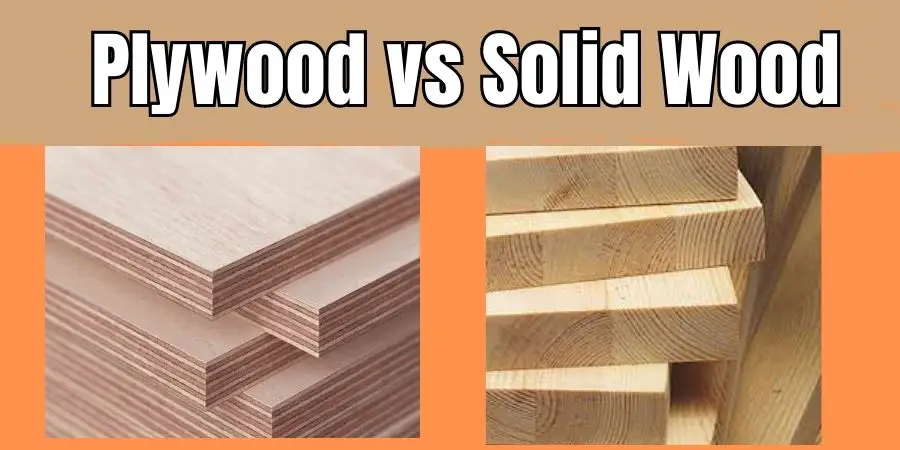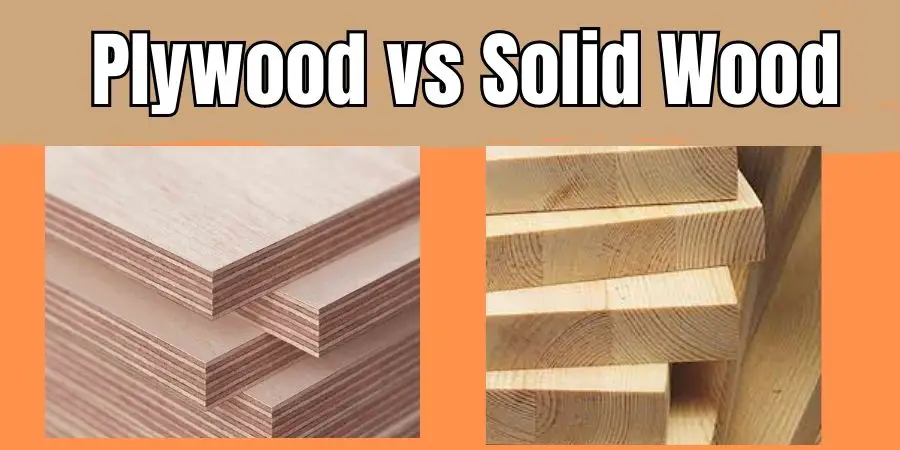When it comes to choosing the right type of wood for your project, you might be wondering whether to go with plywood or solid wood. Here are some key differences to consider:
Table of Contents
Plywood vs Solid Wood

Plywood is More Affordable
If you’re on a tight budget, plywood might be the better option for you. It’s generally more affordable than solid wood because it’s made from thin layers of wood that are glued together. This makes it easier to produce and less expensive than solid wood.
Solid Wood Has a More Natural Look
If you’re looking for a natural and rustic look, solid wood is the way to go. It has a unique appearance with visible grains and knots, which can add character and charm to your project. Plywood, on the other hand, has a more uniform appearance, but can be designed to mimic the look of solid wood with veneers.
Plywood is Strong and Durable
Don’t be fooled by its thin layers – plywood is surprisingly strong and durable. It’s resistant to warping, cracking, and splitting, and can withstand various environmental conditions. It’s also ideal for projects that require flexibility and bending, such as curved furniture pieces.
Solid Wood is Stronger and More Durable
While plywood is strong and durable, solid wood is generally even stronger and more durable. It’s less susceptible to warping, cracking, and splitting than plywood, and can withstand more wear and tear over time. It’s also ideal for projects that require stability and longevity, such as structural support and high-quality furniture.
Plywood is Versatile
One of the great things about plywood is that it’s incredibly versatile. It can be used for a wide range of projects, including flooring, cabinets, furniture, and exterior applications like siding and roofing. Its affordability and durability make it an attractive option for practical projects.
Solid Wood is More Customizable
If you’re looking for a material that can be easily customized and shaped to your liking, solid wood is the way to go. It can be carved, sanded, and shaped into intricate designs, making it ideal for decorative trim and molding. Its natural beauty also makes it a popular choice for high-end furniture pieces.
Plywood vs solid- Differences
Composition: Solid wood is made from a single piece of wood, while plywood is made from several layers of thin wood veneers glued together with the grain running in alternating directions.
Strength and Durability: Solid wood is generally stronger and more durable than plywood, as it is less susceptible to warping, cracking, and splitting. However, plywood is also strong and durable and can resist impact and bending better than solid wood.
Appearance: Solid wood has a natural and unique appearance, with visible grains and knots, while plywood has a more uniform appearance. However, plywood can be designed to mimic the look of solid wood with veneers.
Cost: Solid wood is usually more expensive than plywood, as it is a premium material with a limited supply. Plywood is cheaper due to the ability to produce it in bulk.
Environmental impact: Solid wood is a renewable resource, but the use of unsustainable forestry practices can lead to deforestation. Plywood can be made from sustainable sources and using fewer trees by using thinner veneers.
Plywood vs Solidwood- Similarities
- Wood-based materials: Both solid wood and plywood are wood-based materials that are widely used in furniture and construction.
- Natural appearance: Both materials have a natural and unique appearance, with visible grains and patterns.
- Strength and durability: Both materials are strong and durable, and can withstand various environmental conditions.
- Versatility: Both materials can be used for a wide range of applications, including flooring, cabinets, furniture, and structural support.
- Workability: Both materials are easy to cut, sand, and shape, making them ideal for customization and intricate designs.
Plywood vs Solidwood- uses
Uses of Plywood:
- Flooring: Plywood is often used as a subflooring material and for underlayment.
- Cabinets: Plywood is a popular material for making cabinets due to its strength, durability, and affordability.
- Furniture: Plywood can be used to make various furniture pieces such as tables, chairs, and shelves.
- Wall paneling: Plywood is commonly used for wall paneling and can be painted or finished for a decorative look.
- Exterior applications: Plywood can be used for exterior applications such as siding, roofing, and sheathing due to its ability to withstand moisture and weather.
Uses of Solid Wood:
- Furniture: Solid wood is a popular choice for making high-quality furniture due to its strength and natural beauty.
- Flooring: Solid wood flooring is highly desirable due to its durability and unique appearance.
- Decorative trim and molding: Solid wood is often used for decorative trim and molding due to its ability to be carved and shaped.
- Structural support: Solid wood is commonly used for structural support in buildings and bridges due to its strength and durability.
- Musical instruments: Solid wood is often used in the construction of musical instruments due to its ability to resonate and produce quality sound.
Plywood vs Solid wood- FAQs
What is plywood made of?
Plywood is made of thin layers of wood, known as veneers, that are glued together to create a strong and durable material. The grain of each layer is rotated by 90 degrees to improve its strength and stability.
How is solid wood different from plywood?
Solid wood is made from a single piece of wood, while plywood is made of thin layers of wood that are glued together. Solid wood has a more natural appearance and is generally stronger and more durable than plywood.
What are some common uses of plywood?
Plywood can be used for a wide range of applications, including flooring, cabinets, furniture, wall paneling, and exterior applications such as siding, roofing, and sheathing.
What are some common uses of solid wood?
Solid wood is commonly used for high-quality furniture, flooring, decorative trim and molding, structural support, and musical instruments.
Is plywood more affordable than solid wood?
Yes, plywood is generally more affordable than solid wood because it’s made from thin layers of wood that are glued together, making it easier to produce and less expensive than solid wood.
Which one is stronger, plywood or solid wood?
While plywood is strong and durable, solid wood is generally even stronger and more durable. It’s less susceptible to warping, cracking, and splitting than plywood, and can withstand more wear and tear over time.
Can plywood be customized?
Plywood can be customized to a certain extent, but it’s not as customizable as solid wood. It can be cut, sanded, and painted, and can be designed to mimic the look of solid wood with veneers.
Is solid wood eco-friendly?
Solid wood can be eco-friendly if it’s sourced from sustainable forests and harvested responsibly. Plywood can also be eco-friendly if it’s made from sustainably sourced wood and produced in an environmentally friendly manner.





